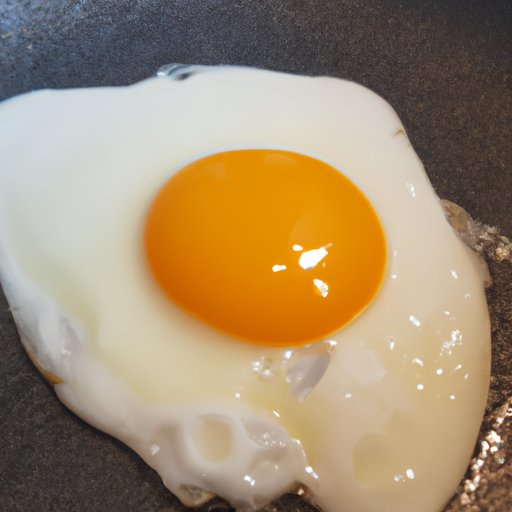
I. Introduction
Whether you’re a novice cook or a seasoned chef, cooking the perfect egg can be a daunting task. But fear not! In this article, we’ll take you through the basics of cooking eggs, provide tips and tricks for a flawless result, and offer delicious recipes to help you put your new skills to the test.
II. The Perfectly Cooked Egg: A Beginner’s Guide
The key to cooking a perfect egg lies in understanding the different cooking times and methods. Boiled, scrambled, fried, poached, and baked eggs all come with their own set of challenges and require different techniques to achieve the desired level of doneness, texture, and flavor. Here’s a step-by-step guide:
Boiled Eggs: To boil an egg, place it in a pot of boiling water and let it simmer for 4-6 minutes for a soft-boiled egg or 8-12 minutes for a hard-boiled egg. Once it’s done, remove the egg from the water and rinse it under cold water to stop the cooking process.
Scrambled Eggs: Beat eggs in a bowl and season them with salt and pepper. Heat a non-stick pan over low heat and add a small amount of butter or oil. Once it’s melted, pour in the eggs and continually stir with a spatula until they form curds and are cooked through, but still moist.
Fried Eggs: Heat a frying pan over medium heat and add butter or oil. Once it’s heated, crack the egg into the pan and cook it for 2-3 minutes for sunny-side-up or 4-5 minutes for over-easy. Once it’s cooked, remove the egg from the pan and serve.
Poached Eggs: Heat a pot of water to a rolling boil and add a tablespoon of vinegar. Crack the egg into a small bowl and carefully slide it into the water. Cook the egg for 2-3 minutes before removing it with a slotted spoon.
Baked Eggs: Preheat the oven to 350°F and grease a ramekin dish. Crack an egg into it and bake for 12-15 minutes or until the white is set and the yolk is runny. Serve immediately.
Now that you know the basic methods for cooking eggs, you’re ready to move on to more complex recipes.
III. Egg-citing Recipes for Breakfast, Lunch, and Dinner
You’re not stuck with the traditional egg dishes for breakfast anymore. We’ve got recipes that range from classic breakfast dishes to more complicated entrees and side dishes. Here are just a few:
Classic Deviled Eggs: hard-boiled eggs, mayonnaise, mustard, salt, and pepper
Egg and Hummus Wrap: whole-wheat tortilla, hummus, sliced cucumber, sliced tomato, and a scrambled egg
Frittata: eggs, ricotta cheese, spinach, garlic, and sun-dried tomatoes
Shakshuka: diced tomatoes, onion, garlic, cumin, paprika, and eggs poached in the sauce
These recipes are easy to make, delicious, and perfect for any meal of the day. And by adding a salad or vegetables to the dishes, you can make them even more nutritious.
IV. Healthy Eating with Eggs: Nutritional Benefits and Tips for Cooking
Eggs are not only tasty but also incredibly nutritious. One large egg contains 6 grams of protein, vitamins A, D, E, and K, and minerals like iron, calcium, and zinc. Here are some tips for incorporating eggs in a healthy and balanced way:
– Use low-fat cooking methods like grilling or poaching to reduce the amount of added fat.
– Pair eggs with vegetables or fruit to make a well-rounded meal.
– Include omega-3-rich eggs in your diet to support brain and heart health.
– Don’t shy away from the yolk since it contains most of the egg’s nutrients.
Contrary to popular belief, eggs are not bad for your cholesterol levels. In fact, studies have shown that consuming up to one egg per day does not increase the risk of heart disease in healthy individuals.
V. Egg-cellent Hacks for a Flawless Egg Every Time
If you’re looking for ways to take your egg game to the next level, try out these expert tips and tricks:
– Use a timer to track the cooking time and achieve the desired level of doneness.
– Use room temperature eggs to prevent cracking when boiling or poaching.
– Add a pinch of salt or other seasonings to the egg mixture before cooking for an extra burst of flavor.
– To peel boiled eggs easily, gently tap them on a hard surface and roll them between your hands before peeling.
These hacks may seem small, but they can make a huge difference in the final product. Give them a shot and see how much your egg-cooking improves!
VI. Eggs Around the World: Exploring International Egg Dishes
Eggs are a staple ingredient in many cultures around the world, and each country has its own unique take on how to prepare them. Here are just a few examples:
Spain: Huevos a la Flamenca – baked eggs with tomato sauce and vegetables
Japan: Tamagoyaki – omelet with soy sauce, sugar, and mirin
Morocco: Msemen – crispy flatbread filled with local cheese and an egg mixture
India: Anda Curry – scrambled eggs in a spicy tomato sauce with onion and garlic
These dishes are flavorful, unique, and provide a glimpse of the different cuisines that exist around the globe. Try cooking one of them at home and see how it compares to your usual egg dishes.
VII. Conclusion
Cooking the perfect egg may seem like an art, but with the right techniques, it’s achievable for everyone. From boiled eggs to international dishes, we’ve covered the basics of cooking eggs, offered tips for perfecting your technique, and shared delicious recipes for any meal of the day.
So what are you waiting for? Grab some eggs, follow our tips and tricks, and see how much your cooking skills improve. And don’t forget to share your own egg recipes and tips in the comments below or on social media.




